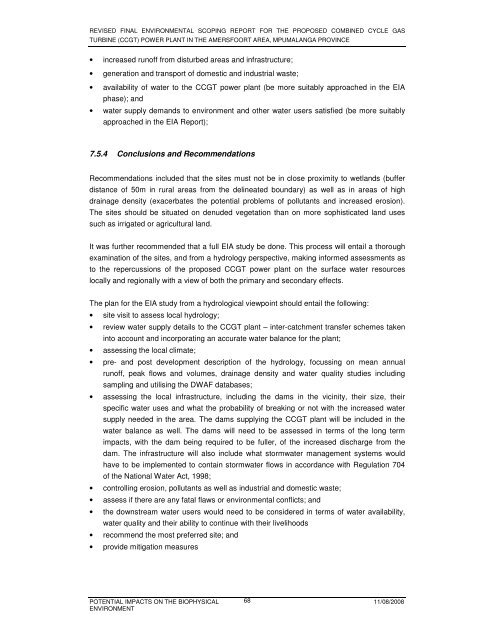Final ESR - Part 2 - Eskom
Final ESR - Part 2 - Eskom
Final ESR - Part 2 - Eskom
You also want an ePaper? Increase the reach of your titles
YUMPU automatically turns print PDFs into web optimized ePapers that Google loves.
REVISED FINAL ENVIRONMENTAL SCOPING REPORT FOR THE PROPOSED COMBINED CYCLE GAS<br />
TURBINE (CCGT) POWER PLANT IN THE AMERSFOORT AREA, MPUMALANGA PROVINCE<br />
• increased runoff from disturbed areas and infrastructure;<br />
• generation and transport of domestic and industrial waste;<br />
• availability of water to the CCGT power plant (be more suitably approached in the EIA<br />
phase); and<br />
• water supply demands to environment and other water users satisfied (be more suitably<br />
approached in the EIA Report);<br />
7.5.4 Conclusions and Recommendations<br />
Recommendations included that the sites must not be in close proximity to wetlands (buffer<br />
distance of 50m in rural areas from the delineated boundary) as well as in areas of high<br />
drainage density (exacerbates the potential problems of pollutants and increased erosion).<br />
The sites should be situated on denuded vegetation than on more sophisticated land uses<br />
such as irrigated or agricultural land.<br />
It was further recommended that a full EIA study be done. This process will entail a thorough<br />
examination of the sites, and from a hydrology perspective, making informed assessments as<br />
to the repercussions of the proposed CCGT power plant on the surface water resources<br />
locally and regionally with a view of both the primary and secondary effects.<br />
The plan for the EIA study from a hydrological viewpoint should entail the following:<br />
• site visit to assess local hydrology;<br />
• review water supply details to the CCGT plant – inter-catchment transfer schemes taken<br />
into account and incorporating an accurate water balance for the plant;<br />
• assessing the local climate;<br />
• pre- and post development description of the hydrology, focussing on mean annual<br />
runoff, peak flows and volumes, drainage density and water quality studies including<br />
sampling and utilising the DWAF databases;<br />
• assessing the local infrastructure, including the dams in the vicinity, their size, their<br />
specific water uses and what the probability of breaking or not with the increased water<br />
supply needed in the area. The dams supplying the CCGT plant will be included in the<br />
water balance as well. The dams will need to be assessed in terms of the long term<br />
impacts, with the dam being required to be fuller, of the increased discharge from the<br />
dam. The infrastructure will also include what stormwater management systems would<br />
have to be implemented to contain stormwater flows in accordance with Regulation 704<br />
of the National Water Act, 1998;<br />
• controlling erosion, pollutants as well as industrial and domestic waste;<br />
• assess if there are any fatal flaws or environmental conflicts; and<br />
• the downstream water users would need to be considered in terms of water availability,<br />
water quality and their ability to continue with their livelihoods<br />
• recommend the most preferred site; and<br />
• provide mitigation measures<br />
POTENTIAL IMPACTS ON THE BIOPHYSICAL<br />
ENVIRONMENT<br />
68<br />
11/08/2008
















